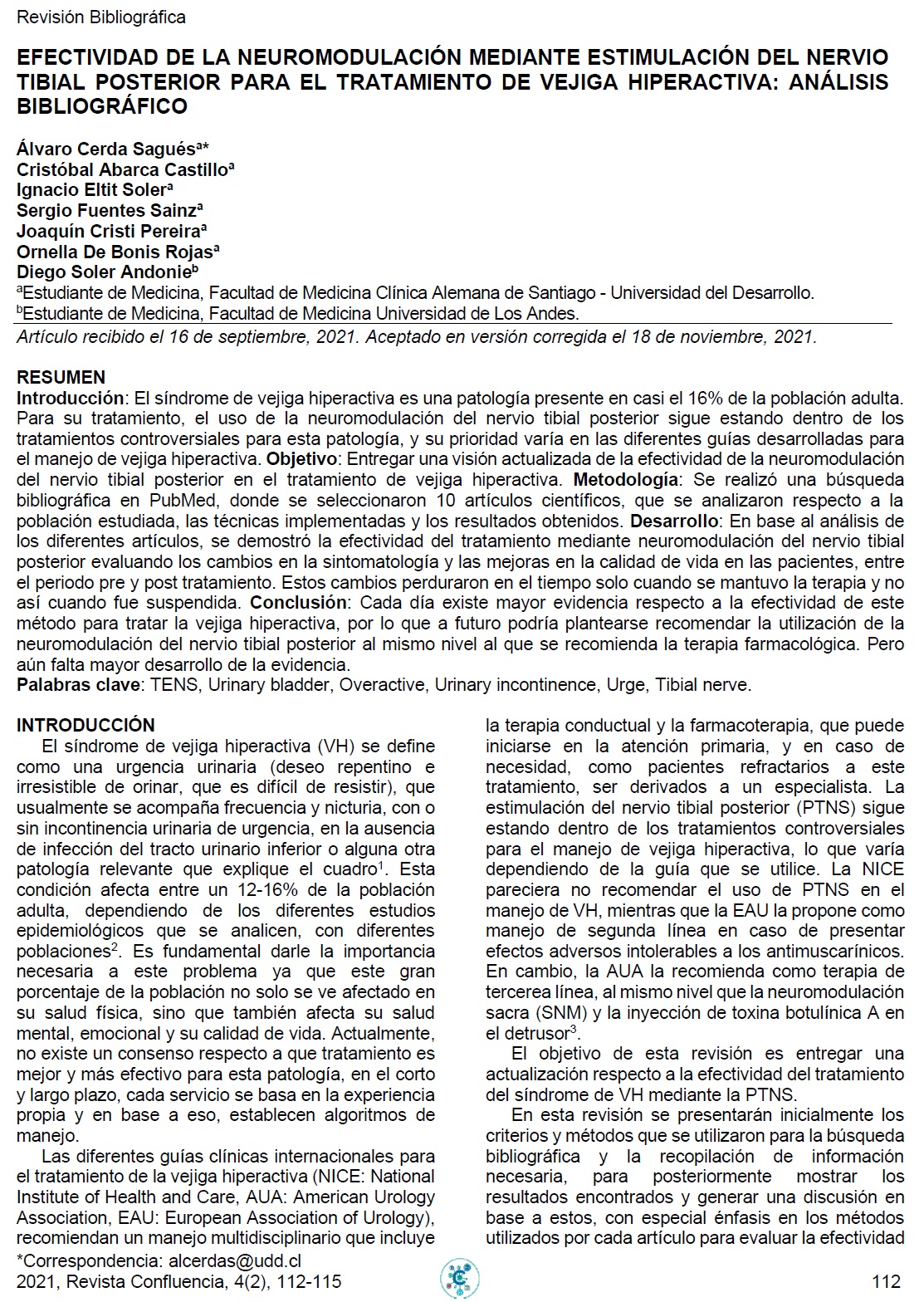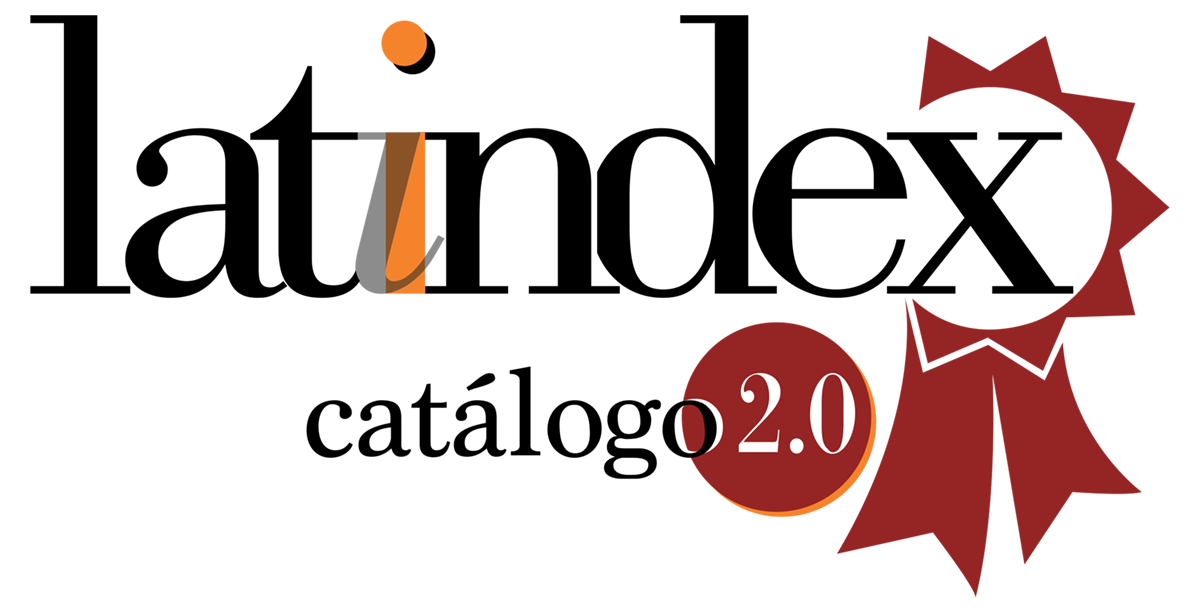Efectividad de la neuromodulación mediante estimulación del nervio tibial posterior para el tratamiento de vejiga hiperactiva: análisis bibliográfico
DOI:
https://doi.org/10.52611/confluencia.num2.2021.636Palabras clave:
TENS, Urinary bladder, Overactive, Urinary incontinence, Urge, Tibial nerveResumen
Introducción: El síndrome de vejiga hiperactiva es una patología presente en casi el 16% de la población adulta. Para su tratamiento, el uso de la neuromodulación del nervio tibial posterior sigue estando dentro de los tratamientos controversiales para esta patología, y su prioridad varía en las diferentes guías desarrolladas para el manejo de vejiga hiperactiva. Objetivo: Entregar una visión actualizada de la efectividad de la neuromodulación del nervio tibial posterior en el tratamiento de vejiga hiperactiva. Metodología: Se realizó una búsqueda bibliográfica en PubMed, donde se seleccionaron 10 artículos científicos, que se analizaron respecto a la población estudiada, las técnicas implementadas y los resultados obtenidos. Desarrollo: En base al análisis de los diferentes artículos, se demostró la efectividad del tratamiento mediante neuromodulación del nervio tibial posterior evaluando los cambios en la sintomatología y las mejoras en la calidad de vida en las pacientes, entre el periodo pre y post tratamiento. Estos cambios perduraron en el tiempo solo cuando se mantuvo la terapia y no así cuando fue suspendida. Conclusión: Cada día existe mayor evidencia respecto a la efectividad de este método para tratar la vejiga hiperactiva, por lo que a futuro podría plantearse recomendar la utilización de la neuromodulación del nervio tibial posterior al mismo nivel al que se recomienda la terapia farmacológica. Pero aún falta mayor desarrollo de la evidencia.
Descargas
Citas
Haylen, B. T., de Ridder, D., Freeman, R. M., et al. An International Urogynecological Association (IUGA)/International Continence Society (ICS) joint report on the terminology for female pelvic floor dysfunction. Int Urogynecol J [Internet], 2009 [citado el 18 de julio, 2021];21(1),5-26. doi:10.1007/s00192-009-0976-9
Eapen R, Radomski S. Review of the epidemiology of overactive bladder. Res. Rep. Urol [Internet], 2016 [citado el 18 de julio, 2021];8:71-6. Disponible en: https://doi.org/10.2147/RRU.S102441
C Fontaine, E Papworth et al. Update on the management of overactive baldder. Ther Adv Urology [Internet], 2021 [citado el 18 de julio, 2021];13:1-9. Disponible en: https://doi.org/10.1177/17562872211039034
Schreiner L, Nygaard C, dos Santos T, et al. Transcutaneous tibial nerve stimulation to treat urgency urinary incontinence in older women: 12-month follow-up of a randomized controlled trial. Int Urogynecol J [Internet], 2020 [citado el 18 de julio, 2021];32(3),687-93. doi: 10.1007/s00192-020-04560-6
Jacomo R, Alves A, et al. Transcutaneous tibial nerve stimulation versus parasacral stimulation in the treatment of overactive bladder in elderly people: a triple-blinded randomized controlled trial. Clinics (Sao Paulo) [Internet]. 2020 [citado el 18 de julio, 2021]; 10(75):1477. doi: 10.6061/clinics/2020/e1477.
Manríquez V, Guzmán R, Naser M, et al. Transcutaneous posterior tibial nerve stimulation versus extended release oxybutynin in overactive bladder patients. A prospective randomized trial. Eur. J. Obstet. Gynecol. [Internet]. 2016 [citado el 18 de julio, 2021];196,6-10. Disponible en: https://doi.org/10.1016/j.ejogrb.2015.09.020
Eftekhar T, Teimoory N, Miri E, et al. Posterior tibial nerve stimulation for treating neurologic bladder in women: a randomized clinical trial. Acta Med Iran [Internet]. 2014 [citado el 18 de julio, 2021];52(11):816-21. PMID: 25415813.
Onal M, Ugurlucan F, Yalcin O. The effects of posterior tibial nerve stimulation on refractory overactive bladder syndrome and bladder circulation. Archives of Gynecology and Obstetrics [Internet], 2012 [citado el 18 de julio, 2021];286(6),1453-7. doi: 10.1007/s00404-012-2464-6
Sherif H, Khalil M, Omar R. Management of refractory idiopathic overactive bladder: intradetrusor injection of botulinum toxin type A versus posterior tibial nerve stimulation. Can J Urol [Internet]. 2017 [citado el 18 de julio, 2021];24(3),8838-46. PMID: 28646940.
Martin-Garcia M, Crampton J. A single-blind, randomized controlled trial to evaluate the effectiveness of transcutaneous tibial nerve stimulation (TTNS) in Overactive Bladder symptoms in women responders to percutaneous tibial nerve stimulation (PTNS). Physiotherapy [Internet]. 2019 [citado el 18 de julio, 2021];105(4),469-75. Disponible en: https://doi.org/10.1016/j.physio.2018.12.002
Ramírez-García I, Blanco-Ratto L, et al. Efficacy of transcutaneous stimulation of the posterior tibial nerve compared to percutaneous stimulation in idiopathic overactive bladder syndrome: Randomized control trial. Neurourol. Urodyn. [Internet]. 2019 [citado el 18 de julio, 2021];38(1),261-8. doi: 10.1002/nau.23843
Scaldazza C, Morosetti C, et al. Percutaneous tibial nerve stimulation versus electrical stimulation with pelvic floor muscle training for overactive bladder syndrome in women: results of a randomized controlled study. Int Braz J Urol [Internet]. 2017 [citado el 18 de julio, 2021];43(1),121-6. doi: 10.1590/S1677-5538.IBJU.2015.0719
Peters K, Carrico D, Wooldridge L, et al. Percutaneous tibial nerve stimulation for the long-term treatment of overactive bladder: 3-year results of the STEP study. Urol [Internet], 2013 [citado el 18 de julio, 2021];189(6):2194-201. Disponible en: https://doi.org/10.1016/j.juro.2012.11.175
Espuña M, Castro D, et al. Comparación entre el cuestionario "ICIQ-UI Short Form" y el "King's Health Questionnaire" como instrumentos de evaluación de la incontinencia urinaria en mujeres. Actas Urol Esp [Internet]. 2007 [citado el 18 de julio, 2021];31(5):502-10. Disponible en: http://scielo.isciii.es/scielo.php?script=sci_arttext&pid=S0210-48062007000500010&lng=es
Hand C. Measuring health-related quality of life in adults with chronic conditions in primary care settings: Critical review of concepts and 3 tools. Can. Fam. Physician [Internet]. 2016 [citado el 18 de julio, 2021];62(7),375-83. Disponible en: https://www.ncbi.nlm.nih.gov/pmc/articles/PMC4955103/
Schurch, B., Denys, P., Kozma, C. M., Reese, P. R., Slaton, T., & Barron, R. Reliability and Validity of the Incontinence Quality of Life Questionnaire in Patients With Neurogenic Urinary Incontinence. Arch. Phys. Med. Rehabil [Internet]. 2007 [citado el 18 de julio, 2021],88(5): 646-52. doi:10.1016/j.apmr.2007.02.009

Descargas
Publicado
Cómo citar
Número
Sección
Licencia
Derechos de autor 2021 Revista Confluencia

Esta obra está bajo una licencia internacional Creative Commons Atribución-NoComercial-SinDerivadas 4.0.








